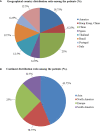The clinical characteristics and gene mutations associated with thyroid hormone resistance syndrome coexisting with pituitary tumors
- PMID: 36843601
- PMCID: PMC9950495
- DOI: 10.3389/fendo.2023.1131044
The clinical characteristics and gene mutations associated with thyroid hormone resistance syndrome coexisting with pituitary tumors
Abstract
Aims: Resistance to thyroid hormone (RTH) and pituitary tumors are both rare diseases, and the differential diagnosis of these two diseases is difficult in some cases. There are also patients who have both conditions, making diagnosis more difficult. To better understand this aspect, we analyzed the clinical characteristics and gene mutations of RTH coexisting with pituitary tumors.
Methods: Database retrieval was conducted in the PubMed, Cochrane Library, and SinoMed databases, and the search contents were case reports or case series of patients with RTH coexisting with pituitary tumors. The demographic, clinical manifestations, and imaging characteristics of pituitary tumors and gene mutations were summarized.
Results: Thirteen articles involving 16 patients with RTH coexistent with pituitary tumors, consisting of 13 female patients, one male patient, and two patients with unknown sex, were included. The patients were 10 to 79 years old and most patients were 41-55 years old (43.75%). The 16 patients were from seven different countries and three continents (Asia, the Americas, and Europe). All the patients showed an abnormal secretion of TSH, and five patients underwent transsphenoidal surgery. Finally, four patients were pathologically confirmed to have TSHoma. A total of 11 different mutations occurred at nine amino acid sequence sites (251, 310, 344, 347, 383, 429, 435, 438, and 453). Two different mutations occurred in both the no. 435 and no. 453 amino acid sequences. Fourteen patients provided their treatment histories, and all had undergone different treatment regimens.
Conclusions: Patients with both RTH and pituitary tumors had multiple clinical manifestations and different thyroid functions, imaging characteristics of pituitary tumors, genetic mutations of THRβ, and treatments. However, due to the limited number of cases, the patients were mainly women. Further studies with more cases that focus on the mechanism are still needed.
Keywords: THRβ; clinical characteristics; gene mutation; pituitary tumors; thyroid hormone resistance syndrome.
Copyright © 2023 Zhao, Xu, Li, Wang, Liao and Dong.
Conflict of interest statement
The authors declare that the research was conducted in the absence of any commercial or financial relationships that could be construed as a potential conflict of interest.
Figures




Similar articles
-
Clinical and genetic characteristics of a large monocentric series of patients affected by thyroid hormone (Th) resistance and suggestions for differential diagnosis in patients without mutation of Th receptor β.Clin Endocrinol (Oxf). 2014 Dec;81(6):921-8. doi: 10.1111/cen.12556. Epub 2014 Aug 14. Clin Endocrinol (Oxf). 2014. PMID: 25040256
-
A pituitary tumor in a patient with thyroid hormone resistance: a diagnostic dilemma.Thyroid. 2001 Mar;11(3):281-91. doi: 10.1089/105072501750159750. Thyroid. 2001. PMID: 11327621
-
Assessing the clinical and molecular diagnosis of inherited forms of impaired sensitivity to thyroid hormone from a single tertiary center.Endocrine. 2018 Dec;62(3):628-638. doi: 10.1007/s12020-018-1673-6. Epub 2018 Jul 19. Endocrine. 2018. PMID: 30027432
-
[Syndromes of resistance to thyroid hormone and inappropriate secretion of TSH (SITSH)].Nihon Rinsho. 2012 Nov;70(11):1951-7. Nihon Rinsho. 2012. PMID: 23214067 Review. Japanese.
-
An overview of thyroid function tests in subjects with resistance to thyroid hormone and related disorders.Endocr J. 2021 May 28;68(5):509-517. doi: 10.1507/endocrj.EJ21-0059. Epub 2021 May 6. Endocr J. 2021. PMID: 33827995 Review.
Cited by
-
A Case of Thyroid Hormone Resistance Syndrome with a Novel Mutation (c.947G>a) in the THRB Gene: Experience in Diagnosis and Treatment.Int Med Case Rep J. 2024 Nov 13;17:959-964. doi: 10.2147/IMCRJ.S486498. eCollection 2024. Int Med Case Rep J. 2024. PMID: 39559298 Free PMC article.
-
Late-Onset Thyroid Hormone Resistance Following Total Thyroidectomy for Papillary Thyroid Cancer.Cureus. 2025 Mar 16;17(3):e80673. doi: 10.7759/cureus.80673. eCollection 2025 Mar. Cureus. 2025. PMID: 40236334 Free PMC article.
-
Resistance to Thyroid Hormone Beta Due to THRB Mutation in a Patient Misdiagnosed With TSH-Secreting Pituitary Adenoma.JCEM Case Rep. 2024 Aug 1;2(8):luae140. doi: 10.1210/jcemcr/luae140. eCollection 2024 Aug. JCEM Case Rep. 2024. PMID: 39091608 Free PMC article.
-
Clinical Characteristics and Genotype-phenotype Correlation in Turkish Patients with a Diagnosis of Resistance to Thyroid Hormone Beta.J Clin Res Pediatr Endocrinol. 2025 May 27;17(2):191-201. doi: 10.4274/jcrpe.galenos.2024.2024-8-14. Epub 2024 Dec 23. J Clin Res Pediatr Endocrinol. 2025. PMID: 39713907 Free PMC article.
References
Publication types
MeSH terms
LinkOut - more resources
Full Text Sources
Medical

